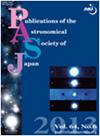m101中的明亮II型超新星2023ixf:早期光谱和近红外光曲线的快速分析
IF 2.2
4区 物理与天体物理
Q2 ASTRONOMY & ASTROPHYSICS
引用次数: 8
摘要
本文在t = 1.7 ~ 8.0 d期间,对m101附近的明亮II型超新星(SN II) 2023ixf的低分辨率(R = 1000)光谱和近红外光曲线进行了早期分析。我们的第一个光谱显示了Balmer系列,He ii, N iii, C iv和N iv的显著发射特征,具有强烈的蓝色连续体。与具有闪烁电离特征的SNe II相比,我们认为该SN可归类为具有富氮/氦的星周物质(CSM)的高亮度SN II,如SNe 2014G、2017ahn和2020pni。Hα发射谱线可以暂时用一个速度<300 km s - 1的较窄分量和一个速度为~ 2200 km s - 1的较宽分量来解释。其近红外光曲线与另一颗发光的SN 2017ahn的近红外光曲线一致,其绝对星等位于SNe II亮度分布的明亮端。这些观测结果支持了SN 2023ixf与高亮度SNe II的一致性,显示了致密的富含氮/氦的CSM的证据。本文章由计算机程序翻译,如有差异,请以英文原文为准。
Bright Type II supernova 2023ixf in M 101: A quick analysis of the early-stage spectra and near-infrared light curves
We present early-stage analyses of low-resolution (R = 1000) optical spectra and near-infrared light curves of the bright Type II supernova (SN II) 2023ixf in the notable nearby face-on spiral galaxy M 101, which were obtained from t = 1.7 to 8.0 d. Our first spectrum showed remarkable emission features of the Balmer series, He ii, N iii, C iv, and N iv with a strong blue continuum. Compared with the SNe II which show flash-ionized features, we suggest that this SN could be categorized as a high-luminosity SN II with a nitrogen/helium-rich circumstellar material (CSM), e.g., SNe 2014G, 2017ahn, and 2020pni. The Hα emission line can be tentatively explained by a narrower component with a velocity of <300 km s−1 and a broader one with ∼2200 km s−1. The near-infrared light curves were well consistent with those of the another luminous SN 2017ahn, and its absolute magnitudes are located at the bright end of the luminosity distribution of SNe II. These observational facts support that SN 2023ixf is well consistent with high-luminosity SNe II showing evidence of a dense nitrogen/helium-rich CSM.
求助全文
通过发布文献求助,成功后即可免费获取论文全文。
去求助
来源期刊

Publications of the Astronomical Society of Japan
地学天文-天文与天体物理
CiteScore
4.10
自引率
13.00%
发文量
98
审稿时长
4-8 weeks
期刊介绍:
Publications of the Astronomical Society of Japan (PASJ) publishes the results of original research in all aspects of astronomy, astrophysics, and fields closely related to them.
 求助内容:
求助内容: 应助结果提醒方式:
应助结果提醒方式:


